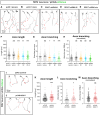Monoallelic de novo variants in DDX17 cause a neurodevelopmental disorder
- PMID: 39405200
- PMCID: PMC11967813
- DOI: 10.1093/brain/awae320
Monoallelic de novo variants in DDX17 cause a neurodevelopmental disorder
Abstract
DDX17 is an RNA helicase shown to be involved in critical processes during the early phases of neuronal differentiation. Globally, we compiled a case series of 11 patients with neurodevelopmental phenotypes harbouring de novo monoallelic variants in DDX17. All 11 patients in our case series had a neurodevelopmental phenotype, whereby intellectual disability, delayed speech and language, and motor delay predominated. We performed in utero cortical electroporation in the brain of developing mice, assessing axon complexity and outgrowth of electroporated neurons, comparing wild-type and Ddx17 knockdown. We then undertook ex vivo cortical electroporation on neuronal progenitors to quantitatively assess axonal development at a single cell resolution. Mosaic ddx17 crispants and heterozygous knockouts in Xenopus tropicalis were generated for assessment of morphology, behavioural assays and neuronal outgrowth measurements. We further undertook transcriptomic analysis of neuroblastoma SH-SY5Y cells, to identify differentially expressed genes in DDX17-KD cells compared to controls. Knockdown of Ddx17 in electroporated mouse neurons in vivo showed delayed neuronal migration as well as decreased cortical axon complexity. Mouse primary cortical neurons revealed reduced axon outgrowth upon knockdown of Ddx17 in vitro. The axon outgrowth phenotype was replicated in crispant ddx17 tadpoles and in heterozygotes. Heterozygous tadpoles had clear neurodevelopmental defects and showed an impaired neurobehavioral phenotype. Transcriptomic analysis identified a statistically significant number of differentially expressed genes involved in neurodevelopmental processes in DDX17-KD cells compared to control cells. We have identified potential neurodevelopment disease-causing variants in a gene not previously associated with genetic disease, DDX17. We provide evidence for the role of the gene in neurodevelopment in both mammalian and non-mammalian species and in controlling the expression of key neurodevelopment genes.
Keywords: RNA helicase; mouse model; neurodevelopmental/motor delay; neuronal development; novel gene disorder; xenopus model.
© The Author(s) 2024. Published by Oxford University Press on behalf of the Guarantors of Brain.
Conflict of interest statement
V.C. acts as consultant and investigator in clinical trials for Chiesi Pharmaceuticals (Leber hereditary optic neuropathy), GenSIght Biologics (Leber hereditary optic neuropathy) and Stealth BioTherapeutics (mitochondrial myopathies). H.L.R. received funding for rare disease research from Illumina and Microsoft.
Figures





References
-
- Bohnsack KE, Yi S, Venus S, Jankowsky E, Bohnsack MT. Cellular functions of eukaryotic RNA helicases and their links to human diseases. Nat Rev Mol Cell Biol. 2023;24:749–769. - PubMed
-
- Bourgeois CF, Mortreux F, Auboeuf D. The multiple functions of RNA helicases as drivers and regulators of gene expression. Nat Rev Mol Cell Biol. 2016;17:426–438. - PubMed
-
- Hilbert M, Karow AR, Klostermeier D. The mechanism of ATP-dependent RNA unwinding by DEAD box proteins. Biol Chem. 2009;390:1237–1250. - PubMed
-
- Linder P, Jankowsky E. From unwinding to clamping—The DEAD box RNA helicase family. Nat Rev Mol Cell Biol. 2011;12:505–516. - PubMed
-
- Fuller-Pace FV. The DEAD box proteins DDX5 (p68) and DDX17 (p72): Multi-tasking transcriptional regulators. Biochim Biophys Acta. 2013;1829:756–763. - PubMed
MeSH terms
Substances
Grants and funding
LinkOut - more resources
Full Text Sources
Molecular Biology Databases
Miscellaneous

